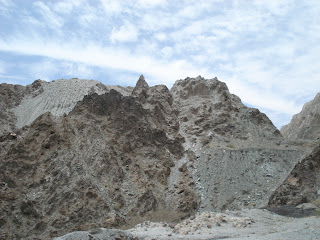Well here we are back in Fujairah again. Fujairah is a tiny Emirate, only 200,000 people. Collectively, the seven Emirates have a population of 8 million. And like all of the Emirates, the majority of the population is expats, mostly from India. The UAE nationals (citizens) are the minority (40% in this Emirate, 18% in the UAE overall), but as in all Emirates they are the ones that get all the benefits from the wealth around here.
Speaking of wealth, we were surprised today to learn that Fujairah has neither oil nor gas. And, of course, the land around here is useless. It is all desert, some of it sand and the rest rocky mountains. Other than in a few small oases, nothing grows around here, unless it is irrigated with expensive water. Water here, as in all the Emirates, costs more than gasoline. So, were does the wealth come from? Look at the picture below.
This is the port at Fujairah. See all the oil storage tanks, as far as the eye can see. It turns out that most of the oil from Abu Dhabi comes from wells in the centre of the country, and it is cheaper to ship the oil from the port of Fujairah than from Abu Dhabi's port. Fujairah's port is on the Gulf on Oman, while Abu Dhabi's is on the Persian Gulf which would require tankers to sail through the nasrrow Straits of Hormuz close to Iran. This would cost the tankers much more in insurance, as well as take an extra couple of days. So, large pipelines, 48 inches diameter, bring the oil from the fields to the storage tanks at Fujairah. We can see the line of tankers waiting to be filled, and it seems to go on forever also. The tankers are too far away for a good picture, so you will have to take our word for it.
Today we had a pretty lazy day. We visited a fort that had been built in the 1500's, but I am sure it has been restored since then. This is the way the rulers lived back in those days.
Then we moved to how people lived and dressed in the 1900's, as depicted in an interesting museum.
The terrain here is rocky, and I almost fell off a cliff.
We learned what a wadi is, and how to go "wadi bashing". Wadis are dry riverbeds, at least they are dry most of the time. They are the traditional means of travel, before there were roads. People still travel on them, but now in ATVs and that is called "wadi bashing".Here is a wadi without a basher, but it looks tempting.
OK, time for a nap this afternoon.
Cheers, P&G
Speaking of wealth, we were surprised today to learn that Fujairah has neither oil nor gas. And, of course, the land around here is useless. It is all desert, some of it sand and the rest rocky mountains. Other than in a few small oases, nothing grows around here, unless it is irrigated with expensive water. Water here, as in all the Emirates, costs more than gasoline. So, were does the wealth come from? Look at the picture below.
This is the port at Fujairah. See all the oil storage tanks, as far as the eye can see. It turns out that most of the oil from Abu Dhabi comes from wells in the centre of the country, and it is cheaper to ship the oil from the port of Fujairah than from Abu Dhabi's port. Fujairah's port is on the Gulf on Oman, while Abu Dhabi's is on the Persian Gulf which would require tankers to sail through the nasrrow Straits of Hormuz close to Iran. This would cost the tankers much more in insurance, as well as take an extra couple of days. So, large pipelines, 48 inches diameter, bring the oil from the fields to the storage tanks at Fujairah. We can see the line of tankers waiting to be filled, and it seems to go on forever also. The tankers are too far away for a good picture, so you will have to take our word for it.
Today we had a pretty lazy day. We visited a fort that had been built in the 1500's, but I am sure it has been restored since then. This is the way the rulers lived back in those days.
Then we moved to how people lived and dressed in the 1900's, as depicted in an interesting museum.
This is the outfit for a weathy woman; black robe and head cover with silver jewelry. Peggy is rethinking her wardrobe for these parts of the world.
We saw a real oasis, complete with an old fort that guarded it once-upon-a-time, and a modern village that now takes advantage of it.
The terrain here is rocky, and I almost fell off a cliff.
We learned what a wadi is, and how to go "wadi bashing". Wadis are dry riverbeds, at least they are dry most of the time. They are the traditional means of travel, before there were roads. People still travel on them, but now in ATVs and that is called "wadi bashing".Here is a wadi without a basher, but it looks tempting.
OK, time for a nap this afternoon.
Cheers, P&G









No comments:
Post a Comment